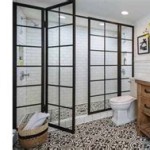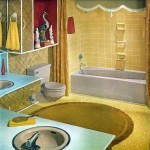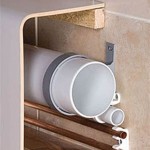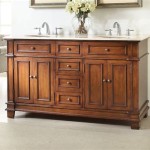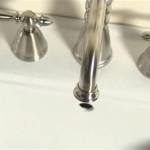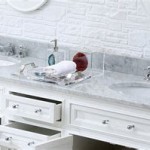Corner Bathroom Vanity With Sink and Mirror: Optimizing Space and Style
The corner bathroom vanity with sink and mirror presents a practical and aesthetically pleasing solution for bathrooms, especially those with limited square footage. This configuration maximizes space utilization by fitting neatly into corners, often underutilized areas within the bathroom layout. This article provides a comprehensive overview of corner bathroom vanities with sinks and mirrors, encompassing their benefits, design considerations, material options, installation guidelines, and selection criteria.
A corner vanity differs from a standard vanity in its design. Standard vanities are rectangular or square and are designed to be positioned against a flat wall. In contrast, a corner vanity is typically triangular or L-shaped, allowing it to fit snugly into a corner of the room. This design variation is crucial in smaller bathrooms where every inch of space counts. The accompanying sink and mirror are designed to complement the shape and size of the vanity, ensuring a cohesive and functional unit.
The integration of a sink and mirror with the vanity creates a unified design element, streamlining the bathroom's appearance and functionality. The sink provides a designated area for washing, while the mirror offers a reflection for grooming and personal care. Together, these components form a central hub within the bathroom, contributing to overall convenience and efficiency.
Key Benefits of Corner Bathroom Vanities
Corner bathroom vanities offer a multitude of advantages, making them a popular choice for homeowners and designers alike. These benefits extend beyond simple space-saving capabilities, impacting the overall functionality and aesthetic appeal of the bathroom. Understanding these advantages is essential when considering a corner vanity for a bathroom renovation or new construction project.
Space Optimization: The primary advantage of a corner vanity is its ability to maximize space usage. By fitting into corners, these vanities reclaim otherwise overlooked areas, freeing up valuable floor space. This is particularly beneficial in small bathrooms where every square inch is crucial. The space saved can be used for other essential fixtures or to create a more open and comfortable environment.
Enhanced Functionality: Despite their compact size, corner vanities can provide ample storage. Many models feature cabinets, drawers, or shelves for storing toiletries, cleaning supplies, and other bathroom essentials. This helps to declutter the countertop and maintain a clean and organized bathroom environment. The integrated sink and mirror further enhance functionality by providing all necessary components for personal hygiene in a single unit.
Aesthetic Appeal: Corner vanities can add a unique design element to the bathroom. Their distinctive shape and placement can create visual interest and break up the monotony of standard rectangular layouts. With a wide range of styles, finishes, and materials available, corner vanities can be customized to match any bathroom décor, from traditional to contemporary.
Design and Material Considerations
Selecting the right design and materials is crucial for ensuring that the corner vanity complements the overall aesthetic and functionality of the bathroom. Several factors must be considered, including the size and layout of the bathroom, the desired style, and the durability and maintenance requirements of different materials. A thoughtful approach to design and material selection will result in a vanity that is both visually appealing and long-lasting.
Vanity Style: Corner vanities are available in a variety of styles, ranging from traditional to modern. Traditional vanities often feature ornate details, raised panel doors, and classic hardware. Modern vanities, on the other hand, tend to be more minimalist, with clean lines, flat-panel doors, and sleek hardware. The choice of style should be based on the overall design theme of the bathroom and the homeowner's personal preferences. Wall-mounted (floating) corner vanities are also an option, providing a modern, space-saving look and ease of cleaning underneath.
Material Selection: The materials used for the vanity cabinet, countertop, and sink can significantly impact its durability, appearance, and maintenance requirements. Common materials include:
- Wood: Offers a classic and warm look, but requires proper sealing to prevent water damage.
- MDF (Medium-Density Fiberboard): An engineered wood product that is more resistant to moisture than solid wood, making it a popular choice for bathroom vanities.
- Plywood: Another engineered wood product that is strong and durable, and can withstand moisture better than solid wood.
- Laminate: A cost-effective option that is easy to clean and maintain, but may not be as durable as other materials.
- Solid Surface: Materials like Corian are non-porous, stain-resistant, and easy to clean, making them an excellent choice for countertops.
- Quartz: A durable and low-maintenance engineered stone that is available in a wide range of colors and patterns.
- Granite: A natural stone that is durable and adds a touch of luxury to the bathroom. It requires sealing to prevent staining.
- Marble: Another natural stone that is elegant and sophisticated, but is more porous and requires more maintenance than granite or quartz.
Sink Type: The sink type is another important consideration. Common options include:
- Undermount Sinks: Installed beneath the countertop, creating a seamless and easy-to-clean surface.
- Vessel Sinks: Sit on top of the countertop, adding a unique and stylish element to the vanity.
- Integrated Sinks: Seamlessly integrated into the countertop, creating a smooth and modern look.
Mirror Design: The mirror should complement the style of the vanity and provide adequate reflection for grooming and personal care. Options include:
- Framed Mirrors: Add a decorative element and can be matched to the vanity's style and finish.
- Frameless Mirrors: Offer a clean and minimalist look.
- Lighted Mirrors: Provide enhanced illumination for grooming.
- Mirrored Cabinets: Offer additional storage space behind the mirror.
Installation and Selection Criteria
Proper installation is essential for ensuring the longevity and functionality of the corner vanity. It is often recommended to hire a professional plumber and carpenter for installation, particularly if plumbing or electrical work is involved. The selection process should involve careful consideration of the bathroom's dimensions, plumbing fixtures, and personal preferences. A well-chosen and properly installed corner vanity will enhance the bathroom's functionality and aesthetic appeal for years to come.
Installation Guidelines: The installation process typically involves the following steps:
- Preparation: Ensure that the corner is clean and free of any obstructions. Turn off the water supply to the existing sink.
- Plumbing: Disconnect the existing plumbing fixtures and prepare the drain and water supply lines for the new vanity.
- Vanity Placement: Carefully position the vanity in the corner and ensure that it is level.
- Attachment: Secure the vanity to the wall using screws or other appropriate fasteners.
- Plumbing Connections: Connect the water supply lines and drain to the sink. Ensure that all connections are watertight.
- Mirror Installation: Mount the mirror on the wall above the vanity. Ensure that it is securely attached.
- Finishing: Apply caulk around the edges of the vanity and sink to seal any gaps and prevent water damage.
Selection Criteria: When selecting a corner bathroom vanity, consider the following factors:
- Size and Dimensions: Measure the corner space carefully to ensure that the vanity will fit properly. Consider the height of the vanity and the amount of space available for movement around it.
- Storage Capacity: Assess the storage needs and choose a vanity with adequate cabinet, drawer, or shelf space.
- Style and Design: Select a vanity that complements the overall aesthetic of the bathroom.
- Material Quality: Choose durable and water-resistant materials that will withstand the humid bathroom environment.
- Budget: Set a budget and compare prices from different retailers and manufacturers.
- Professional Installation: Determine whether professional installation is required or if the project can be completed as a DIY project. If professional installation is needed, obtain quotes from several contractors.
By carefully considering these factors, it is possible to select a corner bathroom vanity with a sink and mirror that meets specific needs and preferences, providing a stylish and functional addition to any bathroom.

Corner Vanities For Small Bathrooms Bathroom Vanity 1 Modern

Good Solution For A Corner Bathroom Vanity Unit Sink Design

Corner Bathroom Vanity With Mirror China Cabinet Made In Com

Corner Bathroom Vanity Ideas My Renovations

20 Beautiful Corner Vanity Designs For Your Bathroom Housely Sink Powder Room Decor

Home Decorators Collection The Depot Corner Sink Bathroom Vanity

Corner Bathroom Vanity Ideas My Renovations

24 Benton Collection Thomasville Taupe Modern Corner Bathroom Vanity Bentoncollections

22 Winstead Corner Vanity In Espresso Base Only

Master Bathroom Corner Vanity Design Ideas
Related Posts


